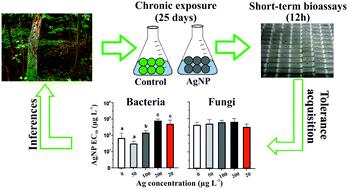当前位置:
X-MOL 学术
›
Environ. Sci.: Nano
›
论文详情
Our official English website, www.x-mol.net, welcomes your
feedback! (Note: you will need to create a separate account there.)
Nanosilver impacts on aquatic microbial decomposers and litter decomposition assessed as pollution-induced community tolerance (PICT)
Environmental Science: Nano ( IF 5.8 ) Pub Date : 2020-06-19 , DOI: 10.1039/d0en00375a Daniela Batista 1, 2, 3, 4, 5 , Ahmed Tlili 6, 7, 8, 9, 10 , Mark O. Gessner 6, 7, 8, 9, 11 , Cláudia Pascoal 1, 2, 3, 4, 5 , Fernanda Cássio 1, 2, 3, 4, 5
Environmental Science: Nano ( IF 5.8 ) Pub Date : 2020-06-19 , DOI: 10.1039/d0en00375a Daniela Batista 1, 2, 3, 4, 5 , Ahmed Tlili 6, 7, 8, 9, 10 , Mark O. Gessner 6, 7, 8, 9, 11 , Cláudia Pascoal 1, 2, 3, 4, 5 , Fernanda Cássio 1, 2, 3, 4, 5
Affiliation

|
The growing proliferation of silver nanoparticles (AgNPs) calls for detailed information on ecotoxicological effects, particularly on diverse communities and key ecosystem processes where impacts remain poorly known. This includes the decomposition of plant litter by fungi and bacteria in streams. Impacts are likely to depend on community composition, because species vary in their sensitivities to stressors. Therefore, our goal was to determine if shifts in microbial communities triggered by chronic exposure to low concentrations of nano (<200 μg L−1) and ionic (20 μg L−1) silver increase community tolerance to these contaminants, as described in the pollution-induced community tolerance (PICT) concept. We used stream microbial decomposers associated with leaf litter in microcosms to assess the applicability of this concept by determining tolerance acquisition towards AgNP and ionic Ag in short-term inhibition assays. Endpoints included fungal sporulation, bacterial production, microbial respiration and the potential activity of a protein-degrading enzyme, leucine aminopeptidase. Analyses of microbial communities showed that chronic exposure to the highest AgNP concentrations led to similar communities, and that these were distinct from the control communities. Most important, chronic exposure of fungi and bacteria to both AgNP and ionic Ag also increased tolerance of the microbes, as revealed by notably reduced adverse effects on bacterial production. Overall, our results demonstrate the usefulness of applying the PICT concept to litter decomposers and decomposition as an approach to assess the risks posed by nano and ionic silver to freshwater ecosystems.
中文翻译:

纳米银对水生微生物分解物和垃圾分解的影响评估为污染引起的社区耐受性(PICT)
银纳米颗粒(AgNPs)的扩散不断增长,需要有关生态毒理效应的详细信息,尤其是对影响尚不甚了解的各种社区和关键生态系统过程的详细信息。这包括溪流中的真菌和细菌分解植物凋落物。影响可能取决于社区组成,因为物种对应激源的敏感性不同。因此,我们的目标是确定在微生物群落移触发由长期暴露于低浓度的纳米(<200微克升-1)和离子(20微克大号-1)银提高了社区对这些污染物的耐受性,如污染引起的社区耐受性(PICT)概念中所述。我们通过在微观世界中使用与叶片凋落物相关的流微生物分解剂,通过在短期抑制试验中确定对AgNP和离子Ag的耐受性获得,来评估该概念的适用性。终点包括真菌孢子形成,细菌产生,微生物呼吸以及蛋白质降解酶亮氨酸氨肽酶的潜在活性。对微生物群落的分析表明,长期暴露于最高AgNP浓度会导致相似的群落,并且这些与对照群落不同。最重要的是,真菌和细菌长期暴露于AgNP和离子Ag也会增加微生物的耐受性,如对细菌生产的不利影响明显减少所揭示。总体而言,我们的结果表明,将PICT概念应用于垃圾分解者和分解作为评估纳米和离子银对淡水生态系统构成风险的一种方法是有用的。
更新日期:2020-07-16
中文翻译:

纳米银对水生微生物分解物和垃圾分解的影响评估为污染引起的社区耐受性(PICT)
银纳米颗粒(AgNPs)的扩散不断增长,需要有关生态毒理效应的详细信息,尤其是对影响尚不甚了解的各种社区和关键生态系统过程的详细信息。这包括溪流中的真菌和细菌分解植物凋落物。影响可能取决于社区组成,因为物种对应激源的敏感性不同。因此,我们的目标是确定在微生物群落移触发由长期暴露于低浓度的纳米(<200微克升-1)和离子(20微克大号-1)银提高了社区对这些污染物的耐受性,如污染引起的社区耐受性(PICT)概念中所述。我们通过在微观世界中使用与叶片凋落物相关的流微生物分解剂,通过在短期抑制试验中确定对AgNP和离子Ag的耐受性获得,来评估该概念的适用性。终点包括真菌孢子形成,细菌产生,微生物呼吸以及蛋白质降解酶亮氨酸氨肽酶的潜在活性。对微生物群落的分析表明,长期暴露于最高AgNP浓度会导致相似的群落,并且这些与对照群落不同。最重要的是,真菌和细菌长期暴露于AgNP和离子Ag也会增加微生物的耐受性,如对细菌生产的不利影响明显减少所揭示。总体而言,我们的结果表明,将PICT概念应用于垃圾分解者和分解作为评估纳米和离子银对淡水生态系统构成风险的一种方法是有用的。











































 京公网安备 11010802027423号
京公网安备 11010802027423号